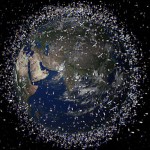‘This is uncomfortably close’: 2 defunct satellites orbiting Earth at risk of colliding, but they could also just pass dangerously close to one another, says private satellite-tracking firm LeoLabs

Two defunct satellites orbiting Earth are at risk of colliding on Wednesday, according to private satellite-tracking company LeoLabs, though they may just simply pass dangerously close to each other.
Should the pair collide, they could potentially create hundreds of pieces of space debris that would threaten other satellites in a similar orbit.
The first satellite, the Infrared Astronomical Satellite (IRAS), a joint venture between NASA and the Netherlands Agency for Aerospace Programmes, was launched in 1983 and is roughly 954 kilograms. The second, smaller GGSE-4 (also known as POPPY 5B) was launched by the U.S. Naval Research Laboratory in 1967 and weighs about 85 kilograms.
Both are now inoperative.
Alan DeClerck, vice-president of business development and strategy for LeoLabs, told CBC News the satellites could miss one another by roughly 15 to 30 metres and that there is a 1 in 100 chance of a collision at a breakneck speed of 14.7 km/s. It would occur 900 kilometres above Pittsburgh at 6:39 p.m. ET.
“In terms of normal operations satellites, one in 10,000 is considered something that you want to take a very close look at. One in 1,000 is considered an emergency,” said DeClerck. “One in 100 is something that any operator would certainly want to do manoeuvre around.”
LeoLabs is a private company with radar in Alaska, Texas and New Zealand capable of tracking satellites and space debris roughly 10 centimetres in diameter. It has plans to track debris as small as about two centimetres in diameter.
In an email statement from a NASA spokesperson to CBC News, the U.S. air force’s Combined Space Operations Center, which is responsible for tracking satellites, has yet to inform the space agency of any pending collision.

However, DeClerck, said the air force doesn’t track satellite debris, which is what the two defunct satellites would be considered.
And according to Jonathan McDowell, an astronomer at Harvard-Smithsonian Center for Astrophysics, who has been closely monitoring the situation, that might be because there are some uncertainties and that not all models will produce the same result.
“The uncertainty on the miss distance is greater than the miss distance,” McDowell said. “We’re in an era now where there are several independent companies as well as the Air Force that track satellites, and their solutions often don’t quite agree at the kilometre level.”
Using what McDowell said is the less reliable public data supplied by the Air Force on satellite orbits, he made his own calculations and got a miss distance of one-and-a-half kilometres, plus-or-minus two kilometres.
“The best thing to say is that this is uncomfortably close,” he said. “It’s more likely there not to be a collision than there will be, but at the same time, a collision wouldn’t be astonishing. So we’ve got to watch it very closely and see if we see any debris afterwards or change in the satellites’ orbits.”
McDowell said there’s one other thing to take into account.
GGSE-4 has 18-metre-long protruding booms, which he doesn’t think are factored into the calculations. Even if those booms do strike the larger IRAS, it’s unclear what that would even do.
DeClerck said LeoLabs will continue to monitor the orbits in the coming hours of the time of closest approach (TCA), and there could be revisions to the orbits. And after the TCA, they will likely know within hours what actually occurred.
If the satellites do collide and produce debris, it won’t be a major addition to the 18,000 pieces of debris currently being tracked, McDowell said, but it could generate about 1,000 more.
But what it does is up the chance of further collisions for satellites in the popular type of orbit called sun-synchronous.
If you’re concerned about pieces falling out of the sky, you needn’t worry: the threat is only to satellites.
“It’s not a things-falling-out-of-the-sky-on-our-heads situation,” McDowell said. “It’s just an increase-in-the-amount-of-ambient-space-debris-in-a-particularly-valuable-orbit kind of thing.”


![[]](https://gallery.mailchimp.com/0c5fce34d5ca05f64a13d085d/images/ea2e7dab-9ec9-4507-907e-ef4644ecc51d.jpg)

